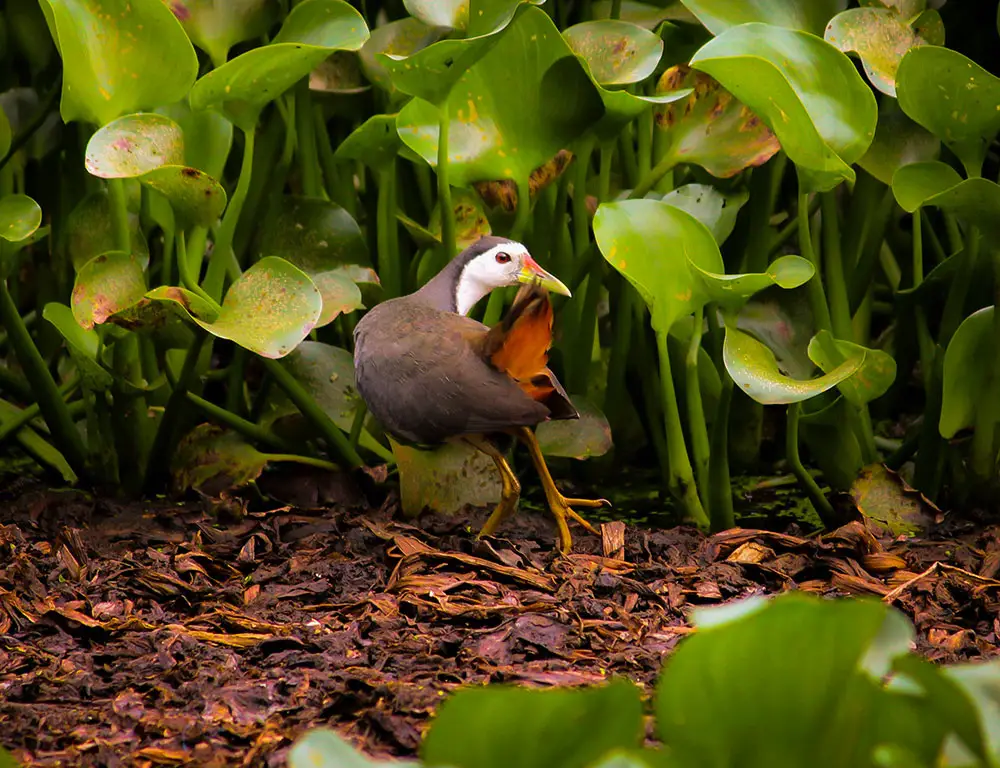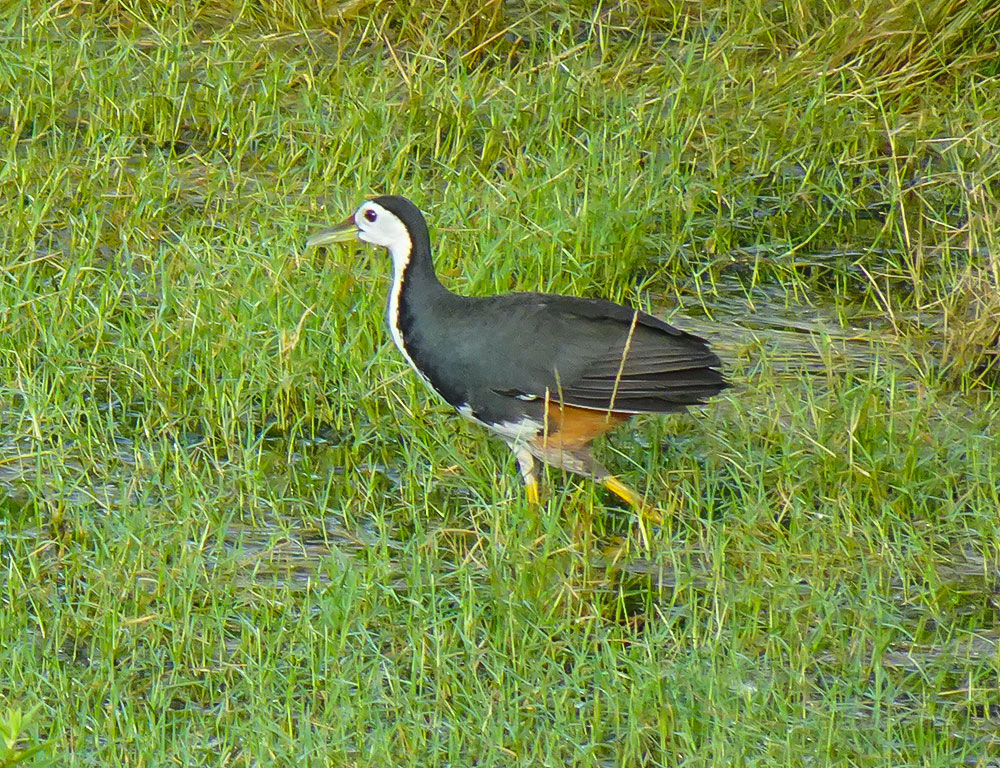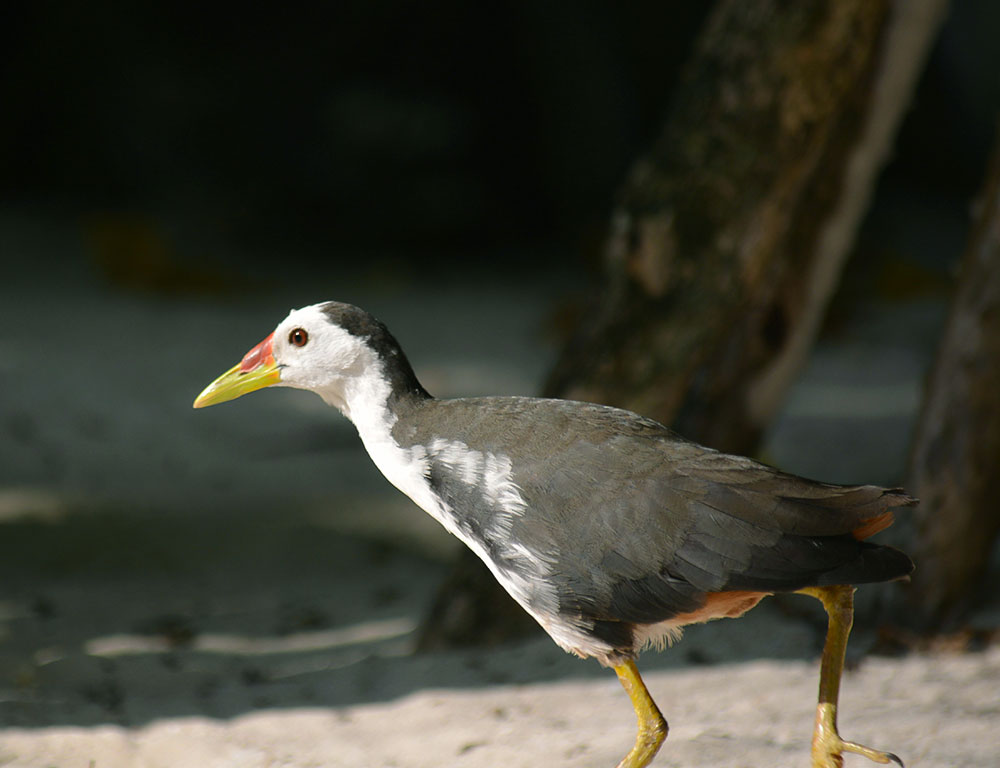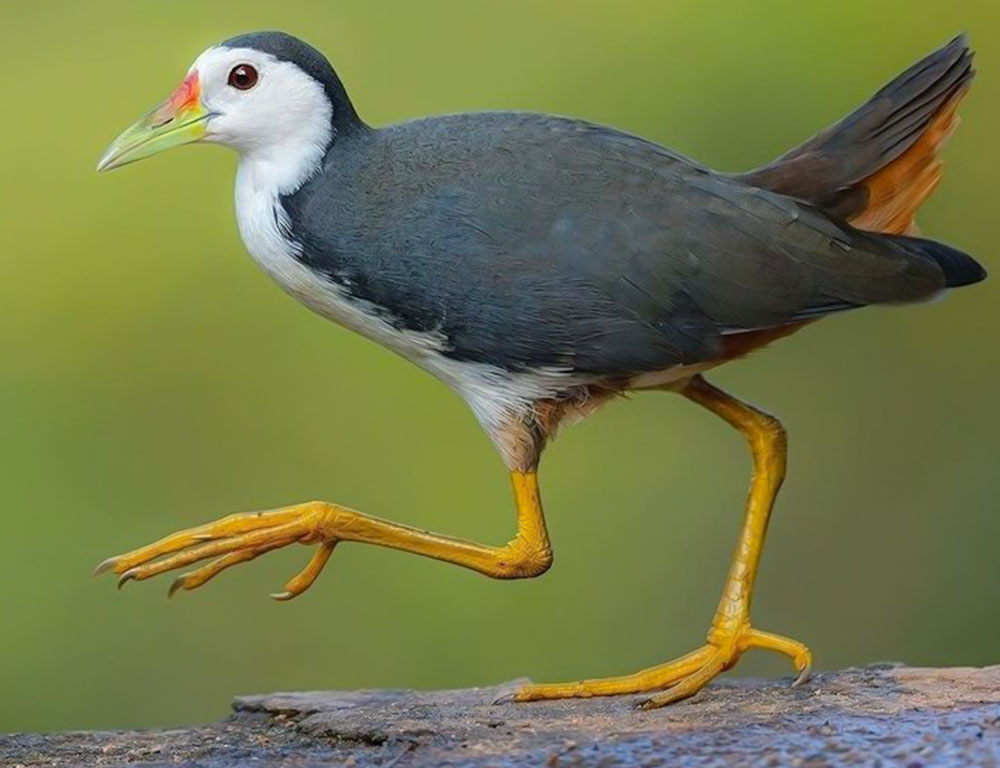Spotting a White-Breasted Waterhen in its natural habitat is an exhilarating experience for birdwatchers like myself. With its glossy black upperparts and striking white underbelly, this medium-sized avian is a true marvel of nature.
Native to Southeast Asia, the White-Breasted Waterhen, scientifically known as Amaurornis phoenicurus, has garnered widespread admiration from ornithologists and nature enthusiasts.
Thriving in marshes, swamps, riverbanks, and various wetland habitats, it sustains itself on a diet of insects, aquatic animals, seeds, and berries.
Its distinct features, including long toes adapted for navigating floating vegetation and resonant croaking calls, make it easily identifiable.
Remarkably adaptable, it fearlessly explores human-altered landscapes, contributing to its stable population amidst mounting habitat pressures.
White-Breasted Waterhen
The White-Breasted Waterhen (Amaurornis phoenicurus) is a captivating bird species with its distinctive appearance, adaptable nature, and intriguing behaviors.
Here’s a summary of its key characteristics:
Appearance
Medium-sized birds with dark slate-grey plumage contrasting sharply with white underparts, particularly the breast and belly. Long legs and toes are adapted for navigating water bodies and wetland habitats.
Habitat
Native to Southeast Asia and Subcontinental India, these waterhens have adapted to various environments, including wetlands, ponds, and urban gardens.
Breeding Season
Breeding occurs between April and July, with males becoming more vocal, using distinct calls as mating displays. Females typically lay 3-7 eggs in nests constructed from twigs and leaves.
Diet
White-Breasted Waterhens are omnivorous, consuming various foods, including insects, small fish, seeds, and berries. Their adaptable diet contributes to their ability to thrive in diverse habitats.
Territorial Behavior
These birds exhibit a strong sense of territoriality, defending their territories vigorously against intruders, including larger bird species or potential predators such as cats or dogs.
Habitat and Distribution of the White-Breasted Waterhen

The White-Breasted Waterhen (Amaurornis phoenicurus) exhibits a fascinating habitat preference and distribution range. As you’ve described, these birds are remarkably adaptable to various wetland habitats and can even thrive in man-made environments.
Here’s a summary of their habitat and distribution:
Habitat
- Marshy Wetlands: White-Breasted Waterhens are commonly found in marshy areas with dense vegetation. These environments provide them with suitable cover and nesting sites.
- Reed Beds: They often inhabit reed beds, where they can efficiently forage for food and build nests hidden among the thick vegetation.
- Freshwater and Brackish Water Bodies: Their preference for areas near freshwater or brackish water bodies, such as lakes, ponds, rivers, and estuaries, is notable. These habitats offer abundant food resources like small invertebrates, fish, and amphibians.
- Man-Made Habitats: Interestingly, White-Breasted Waterhens have adapted to human-altered environments like rice fields, urban parks, and gardens with water features. This adaptability demonstrates their ability to exploit new niches for survival.
Distribution
- South Asia: The distribution range of White-Breasted Waterhens encompasses a significant portion of South Asia, including countries like India, Bangladesh, and Sri Lanka.
- Southeast Asia: They are also found across Southeast Asia, ranging from Indochina (Vietnam, Cambodia, Laos) to southern China (Guangxi, Guangdong) and extending to the Philippines, Borneo, and Java in Indonesia.
- Australia: In Australia, these birds are distributed across northern regions, including New Guinea and as far south as northern Australia. They inhabit wetland areas in these regions.
Altitude Preference
White-Breasted Waterhens prefer low altitudes, rarely venturing beyond 1000 meters above sea level. They are primarily found in lowland areas but can occasionally inhabit slightly elevated terrains if suitable wetland habitats exist.
Human Proximity
White-Breasted Waterhens are known to venture into human surroundings, especially areas with nearby water bodies. This behavior often brings them into urban and suburban environments, where they may frequent parks, gardens, and even residential areas.
Physical Characteristics of the White-Breasted Waterhen

The White-Breasted Waterhen (Amaurornis phoenicurus) indeed possesses a fascinating array of physical characteristics, perfectly adapted for its aquatic lifestyle:
Size
With an average length of around 13 inches, the White-Breasted Waterhen is of moderate size, neither too large nor too small.
Plumage
Its plumage is predominantly dark slaty, providing camouflage in its wetland habitats. The contrasting white underparts and throat area give it its distinctive “white-breasted” appearance.
Beak & Legs
The bright yellowish-green color of its beak and legs serves as a striking contrast against its dark feathers. During the breeding season, these features shift to an even brighter shade of orange-red, likely playing a role in courtship displays.
Wings
Equipped with solid wings, the White-Breasted Waterhen utilizes them primarily for short flights or gliding across water surfaces, aiding in its movement and foraging activities.
Eyes
Its deep red eyes add to its aesthetic appeal and provide excellent vision, crucial for spotting food from afar and detecting potential predators.
Feet
One of this aquatic bird’s most surprising features is claws on each toe, providing exceptional grip when climbing trees or navigating rough terrain, showcasing its adaptability and versatility.
Behavior and Diet of the White-Breasted Waterhen

The behavior and diet of the White-Breasted Waterhen indeed paint a picture of a versatile and adaptable bird ideally suited to its varied habitats:
Territorial Behavior
White-Breasted Waterhens are known for their territorial nature, fiercely defending their habitats from intruders.
They vocalize loudly, emitting shrill calls that echo through the wetlands, communicating with conspecifics and as warnings to potential threats.
Habitat Preference
While these birds are predominantly associated with aquatic habitats, they exhibit equal comfort on land. They can be observed wading in shallow waters, scurrying across open fields, or strutting confidently around gardens.
Omnivorous Diet
The White-Breasted Waterhen boasts an omnivorous diet, consuming various foods. Their menu includes insects such as beetles and crickets, aquatic animals like snails and small fish, seeds from multiple plants, berries, and grains when available.
However, earthworms hold a unique appeal to them.
Adaptability
This bird’s adaptability in both behavior and diet has contributed to its success across diverse ecosystems, ranging from marshy wetlands in Asia to habitats in Australia.
Their ability to exploit various food sources and adapt to different environmental conditions has undoubtedly aided their widespread distribution and survival.
White-Breasted Waterhen Conservation Status

The White-Breasted Waterhen (Amaurornis phoenicurus) is currently classified as ‘Least Concern’ by the International Union for Conservation of Nature (IUCN), indicating that it is not at immediate risk of extinction.
Several factors contribute to this stable status:
Broad Geographical Range
These waterbirds are widely distributed across Asia, from India and Sri Lanka to Indonesia and China. Their ability to inhabit various habitats, including marshes, ponds, agricultural fields, and urban areas, contributes significantly to their stable population.
Adaptability
White-Breasted Waterhens are highly adaptable creatures who thrive in diverse environments. Their omnivorous diet, which includes insects, aquatic life, seeds, and occasionally small mammals or birds, allows them to exploit a wide range of food sources, reducing their vulnerability to environmental changes.
Resilience
Their resilience to habitat modifications and dietary versatility make them less susceptible to immediate threats. However, they are not immune to human-induced pressures, such as habitat loss due to land development and pollution.
Conservation Efforts
While currently not endangered, continuous monitoring and conservation efforts are crucial to ensuring the long-term survival of the White-Breasted Waterhen.
Monitoring their population trends and addressing habitat threats are essential to safeguarding their future.
Conclusion
The White-Breasted Waterhen emerges as an extraordinary species, seamlessly adapted to its environment with a unique blend of physical characteristics and behavioral traits.
Its striking appearance and versatile diet reflect its ability to thrive in wetland habitats. At the same time, intriguing behaviors such as nocturnal activity and monogamous mating patterns add depth to our understanding of its life cycle.
Despite its stable status, ongoing conservation efforts are imperative to ensure its long-term survival. This exploration underscores the importance of continued research and vigilance in protecting the White-Breasted Waterhen and its intricate web of life.
This bird serves as a poignant reminder of the interconnectedness and significance of every species within our ecosystem.